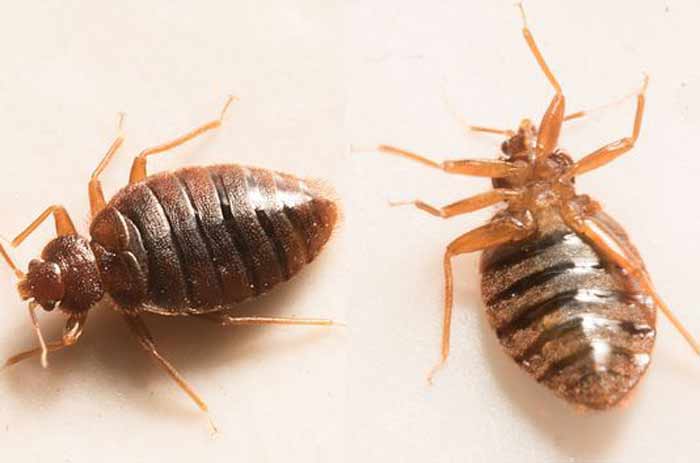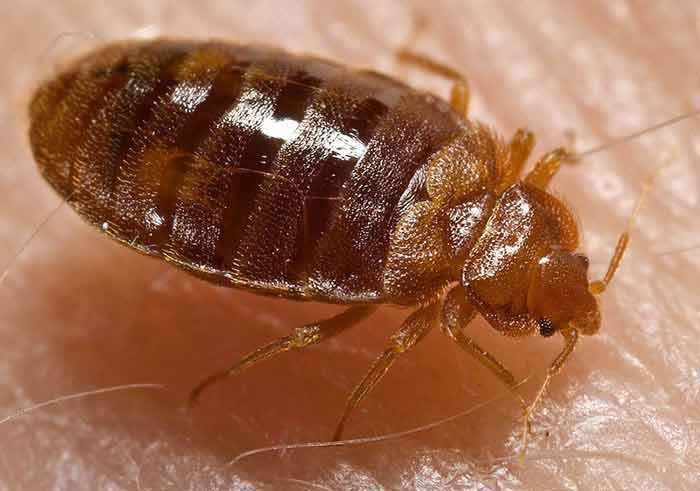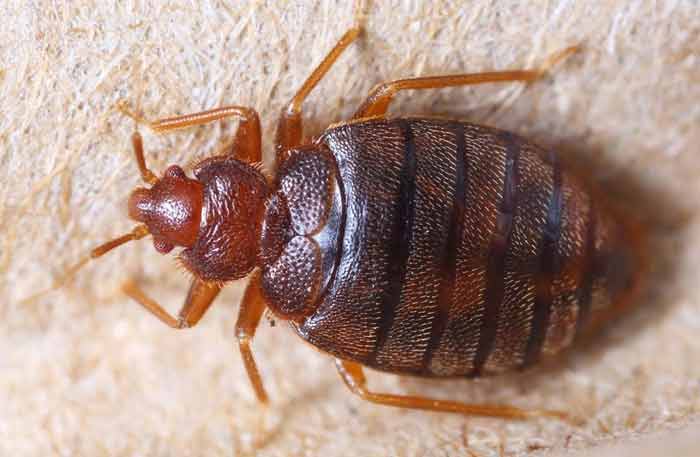How many types of bed bugs exist? What determines the type/species? Are they specific to particular regions of the world or hosts? Read on to find out.
Table of Contents
Are there different types of bed bugs?
Until time in the recent past, bed bugs have always been to be very uncommon in the industrialized countries.
The truth is now very clear that even the developed countries continue to grapple with different types of bed bugs

Bed bugs belong to the family Cimicidae. It is estimated that there are at least 90 species of these bloodsucking insects. However, of the many species only a few feed on human blood. The blood feeding ones are
Cimex Lectularius (household bed bug)
When you hear the term bed bug….Cimex lectularius Linnaeus is in most cases the particular species people referring to.
You may also hear it being referred to as mahogany flats, red coats or chinches. This is most popular type found all over the world and it is thought to be one of the world’s major “nuisance pests”.
These parasitic insects thrive well under human dwellings, bird nests and bat caves mostly in temperate climates.
They feed on humans, bats, chickens and occasionally domesticated animals
C. lectularius goes through five immature life stages that each require a blood meal to develop and move on to the next stage. Blood meals are necessary for each life stage in order to reproduce.
Cimex Hemipterus (Tropical Bed Bug)
Adult tropical bed bugs are reddish-brown and can reach up to 8millimeters in length.
They are solenophages, that is, they feed by piercing blood vessels and drawing up the fluids.
Studies show that Cimex hemipterus males will often interbreed with females of the closely related species Cimex lectularius resulting in sterile eggs.
Cimex lectularius vs Cimex hemipterus
These two species of bed bugs can be easily distinguished by looking at the prothorax, the first segment of the thorax.
The prothorax of the common bed bug is more expanded laterally and the extreme margins are more flattened than that of the tropical bed bug .
Bat bugs (Leptocimex Boueti/Cimex Adjunctus)
Leptocimex Boueti or Cimex Adjunctus are mainly found in the tropical areas as well as the temperate regions.
As their name suggests, they feed mainly on bat blood. However, in absence of bats as hosts, they are more than willing to take on human hosts.
They will feed on human hosts when the bats which they depend on are no longer available.
Under a naked human eye, bat bugs look exactly like the tropical and household bed bugs.
With the help of a microscope there exist differences like fringe hairs on the upper thorax which is longer in bat bugs compared to that in bed bugs
What determines the type
There are factors that could dictate or determine the distribution of bugs or even the bed bugs across the face of the earth. They can range from human related factors to natural climate related factors.
Region country etc.?
According to the Science News Organization, there are two main types of bed bugs in the United States; the Cimex lectularius and the C. hemipterus.
The lectularius species is the commonest and they seem to have reemerged in the period after 1950s. They cause a lot of trouble in homes, hotels, offices and even the public transport.[2]
The C. hemipterus is a new species that seems to be emerging and it causes a lot of trouble as well.
They majorly found in the regions of the earth that surround the equator, from 23.5 degrees north to 23.5 degrees south.
They have been confirmed to be more prominent in Florida, a tropical region, although they have somehow spread to other regions.
According a Kenyan Newspaper (Daily Nation), bed bugs are a real nightmare. The largest infestations are in the university hostels and the high school dormitories.
The bed bugs have over time spread to households more so in the urban areas of Nakuru, Nairobi and Mombasa. The commonest of all the species that are found in these towns is the Cimex lectularius.
Based on the reviews on online platforms, the biggest challenge of bed bugs is seen in cities like Bangalore, Pune, Mumbai and Delhi.
This is because most of the populations stay in shared accommodations. The Cimex lectularius are still the commonest. Their infestation has nothing to do with cleanliness but rather living conditions in particular areas.
Based on above data, it true that human occupancy is a factor when it comes to the household bed bags.
Host
According to the National Center of Biochemistry Institute (NCBI), the C. lectularius feed on you when you are asleep. This means that without a host they will not thrive for long periods.
Initially, these species fed on the cave dwelling bats. They changed their feeding habits when humans invaded the caves and then chased the bats. They had to change their hosts to humans.
It is also evident that bed bugs could visit cats and dogs in human homes. The bed bugs however prefer human blood over the other animals.
They would only have the animals as the last resort when human blood is unavailable. Upon infesting the dogs and cats, they cause a lot of irritation, itching and inflammation of variable intensities.
Bat bugs on the other hand are known feed on bats.
Further Reading
- How to Prevent Bed Bugs-Bites while Sleeping at Home, School, Hotel & Travelling
- How to get rid of Bed Bugs on Clothes-Can they Live, Bite through or Travel on Laundry
- Fumigation for Bed Bugs-Cost & Preparation
- How to get Bed Bugs out of Carpet with Cleaner & Powder
- How Long do Bed Bugs Live Without Food, Host, Air, in Cold & After Spraying
- Bed Bug Rash on Skin, Pictures, Treatment, Allergy & Symptoms
- Where do Bed Bugs Hide and how to Find them
- Mosquito Bites vs Bed Bug Bites-What’ are the differences
- Identifying Bed Bug Eggs- How they look like, Images & destruction
- How do you know if you have Bed Bugs-Symptoms & Signs
- Bed Bug vs Spider Bites- Differences with Pictures
- Bed Bug Sniffing Dogs-How they smell, Sense, Roscoe, Breeds & Cost
- What are Bed Bugs? Names in other Languages
- Where do Bed Bugs come from? Causes, how you get them & Start
- How to Kill/Get Rid of Bed Bugs Fast Yourself Naturally for Good
- Bed Bugs in Hair Symptoms, Pictures & Get rid
- Types of Bed Bugs
- Bed Bug Poop/Droppings-How it looks like, Pictures +Identification
- Bed Bug Shells, Cast Skin & Exoskeleton
- Can you See Bed Bugs with the Naked eye? Pictures, Size, Color & Anatomy
- Dust Mite vs Bed Bug Bites
- Bed Bug life cycle-Eggs, Baby(Nymph) to Adult Stages & Pictures
- How to Detect Bed Bugs-Detectors, Light & Verifi Reviews
- How to know if Bed Bugs are gone after Treatment & what to do
- Will Bleach Kill Bed Bugs-How does it work?
- Best Bed Bugs Traps- DIY Homemade, Co2, Yeast + Reviews
- How to Deal with Bed Bugs in your Car
- Bed Bugs in Couch-Covers, Signs & How to Get rid
- How to Kill Bed Bugs with Steam: Best Steamers & Guide + Tips
- Does Alcohol Kill Bed Bugs? Rubbing, Isopropyl & Percentage
- How Long do Bed Bug Bites Last, Take to Appear, Go Away & Heal
- Natural Predator of Bed Bugs-What Insects/Bugs eat Bed Bugs?
- Can Bed Bugs Live in TVs & Other Electronics? How to get them out
- Do Bed Bug Bites Itch or Hurt?
- Bed Bug Interceptor-How it works, DIY & Reviews
- What do Bed Bug Bites look like? Pictures & Identification Steps
- What Attracts Bed Bugs & things they Hate /Dislike Most
- Can Bed Bugs make you Sick? How are they Dangerous?
- Can Bed Bugs Fly-Do they have Wings-How Far can they Travel
- Diatomaceous Earth for Bed Bugs-How to Use & Best Reviews
- DIY Bed Bug Heat Treatment: Success Rate,Temperature Chart, Preparation & Reviews
- Does Vinegar Kill Bed Bugs? Can it be Used for Bites?
- How to Get Rid of Bed Bugs on Mattress- Best Covers, Protectors & Encasement Reviews
- Can Bed Bugs live on or Bite Dogs & Cats (Pets)?
- Bugs that look like Bed Bugs-Beetles & Others that Resemble or Mistaken
- Bed Bug Bombs-Do Foggers work? Effectiveness & Reviews
- Bed Bug Repellents -Natural Homemade, Creams, Electronic & Reviews
- How do Bed Bugs Spread? Are they Contagious? How Fast/Easily from Person, Room or House?
- Best Bed Bug Sprays-DIY Homemade, Natural, Brand Reviews
- Flea Bites vs Bed Bug Bites + Differences & Pictures
Sources
[1] http://extension.colostate.edu/topic-areas/insects/bat-bugs-bed-bugs-and-relatives-5-574/
[2] https://www.sciencenews.org/blog/wild-things/now-there-are-two-bedbug-species-united-states

